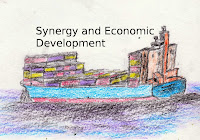Successful development in Southeast Asia often rests
partly in foreign direct investment and multinational firms. The author studied
the investments between Malaysia and Singapore to determine that two-way
investments embedded within business networks fostered synergy for economic growth
(Yeung, 1998). It is a process of creating linkages between two economies, or
entities, to ensure they develop from each other to create products for the
market.
What makes this process possible is that Malaysia
and Singapore invest in each other’s economies. For example, Singapore invests
primarily in services within Malaysia’s primary manufacturing base. Malaysia
becomes an exporter of finished products and returns investment profits back to
companies in Singapore.
As the cross regional investments increase so does
the business connection between the areas. The use of these connections and
cross-capital investments creates a type of synergy based upon the varying
skill sets embedded within each economy. Together they are able to provide
stronger and better products and services that have more appeal on the market.
When countries develop they change from importers to
exporters (Dunning, 1998). This happens when the environment is conducive to
local offerings; competitive strategy effectively reflects that need and the
organizations are aligned to provide adequate products/services (Porter, 1990). The area must align its business operations
and offerings to the market need to effectively grow.
Firms do not need to be owned by the exporting
locality but the region should be the home location where investments turn into
exports (Porter, 1986). The firms were the primary source of success in creating
synergy. At a firm level it was these personal and business connections between
companies that helped to create greater investment and cooperation for economic
growth (Chandler, 1990).
Most of the major firms from each country have cross
operations. These cross operations connect to other networks within the
countries and begin to share resources and knowledge. Significant competitive
advantages can arise when companies from different countries and firms work
together (Yeung, 1998). These are a result of:
-
Long-term relationships that reduce
business uncertainty.
-
Shared resources and information that
offer “first mover” advantages.
-
Increased credit worthiness that
improves financial flow.
-
Once established the system protects
itself.
Chandler, A. (1990) Scale and Scope: The Dynamics
of Industrial Capitalism. Harvard University Press, Cambridge, MA.
Dunning, J. (1998) Explaining International Production.
Unwin Hyman, London.
Porter, M. (1986) Competition in
global industries: a conceptual framework, in PO RT ER M. E. (Ed) Competition
in Global Industries, pp. 15± 60. Harvard Business School Press, Boston.
Porter, M. (1980). The Competitive Advantage of
Nations. Macmillan, London.
Yeung, H. (1998). Transnational economic synergy and
business networks. Regional studies, 22 (8).
Yeung, H. (1998a) The political
economy of transnational corporations: a study of the regionalisation of
Singaporean firms, Pol. Geogr., 17, 389± 416.
